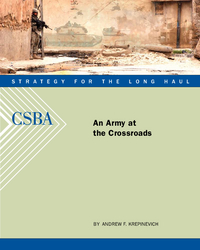
Throughout the twentieth century, the United States Army was oriented primarily on waging conventional warfare against a similarly armed great power, first the German Army during the World Wars and later the Soviet Army during the Cold War.
Likewise, the pre-9/11 Army was designed to fight short, conventional wars against regional powers along the lines of what it experienced during Operation Desert Storm in 1991. Today, however, nearly a half million American soldiers are serving overseas in some eighty countries around the world. Over 2,200 soldiers have been killed in combat operations in Afghanistan and Iraq, and over 17,000 wounded. The garrison Army that fired nary a shot in Central Europe for half a century during the Cold War has, in the first decade of the new century, become a battle-hardened, expeditionary force conducting protracted ground campaigns on two main fronts. Yet for all the change the Army has experienced, more is on the way.
The United States currently faces three major strategic challenges that will dominate its defense policy over the next decade or longer: defeating Islamist terrorist groups, hedging against the rise of a hostile and more openly confrontational China, and preparing for a world in which there are more nuclear-armed regional powers.
These existing or prospective adversaries present very different military challenges from those the Army prepared for during the previous century. Terrorist and insurgent groups employ a modern form of irregular warfare that has, over the past four decades, presented a formidable challenge to the world’s best conventional armies in Vietnam, Afghanistan, Lebanon, and elsewhere. Unlike previous great power competitors, China’s military modernization efforts appear to be centered on the aerospace and maritime domains. Meanwhile, second- and third-tier military powers such as Iran and North Korea have concentrated on developing and fielding weapons of mass destruction, Special Operations Forces, and, in the case of Iran, a substantial irregular warfare capability, rather than building up conventional ground forces.
How should the Army prepare to confront these threats?



























